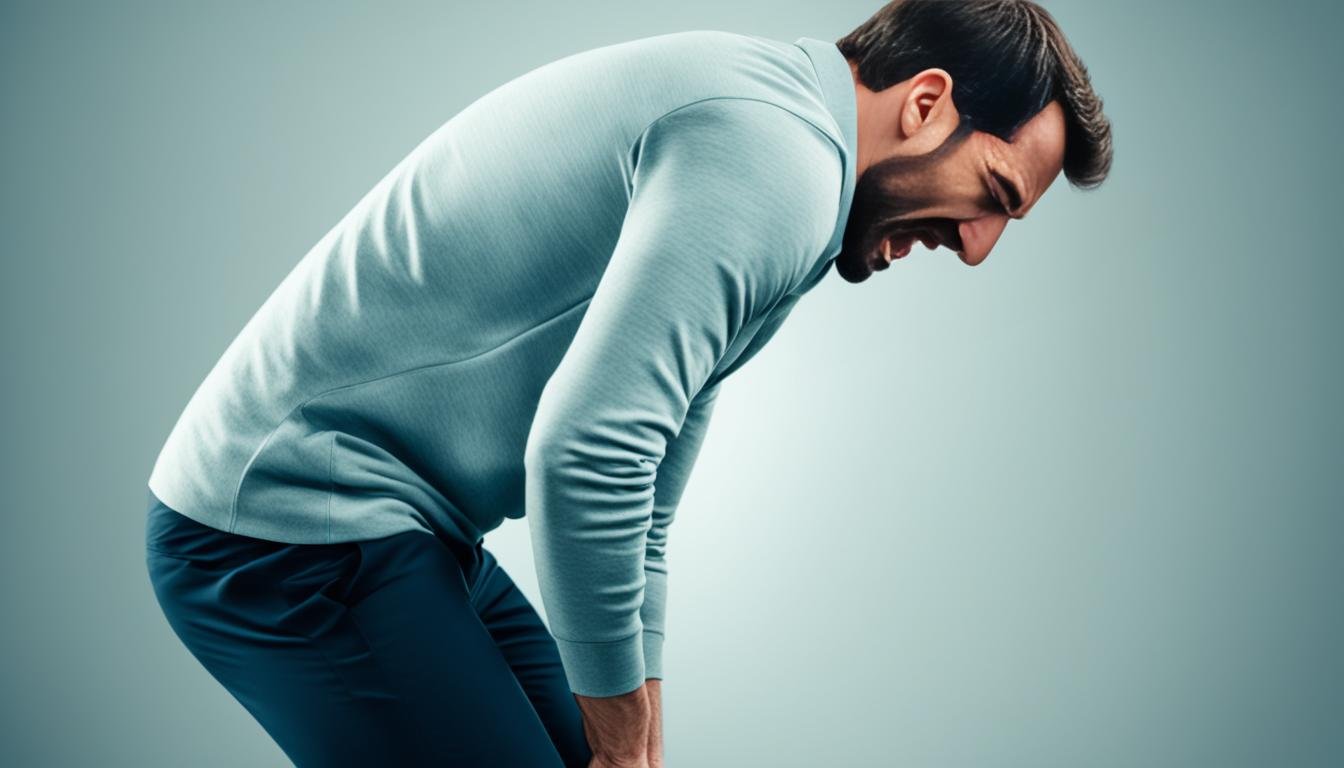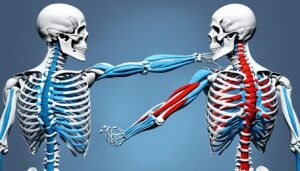Feeling pain in your back when you bend over is tough. It can be sharp or dull but it messes with your day. Good news is, knowing why it happens and finding ways to feel better can change things. You don’t have to live with it.
Around 40% of grown-ups in the US face back pain issues. The problem gets worse when you bend and lift wrong, making your back hurt more. The reasons for back pain when bending are many. It could be simple muscle strains or more serious stuff like herniated discs or sciatica.
In this guide, we’ll look at what makes your back hurt when you bend. We’ll see what really works to feel better. And we’ll share ways to stop this from happening. So, whether you play sports, work at a desk, or just want to keep your back healthy, this info is for you. We’ll show you how to get relief and feel better every day.
Key Takeaways
- Many things can cause back pain when bending, including muscle strain, herniated discs, sciatica, and spinal arthritis.
- Learning to lift and bend right, plus doing exercises to make your core strong, can help a lot.
- Simple things like pain meds, rest, and gentle moving can ease many back pain problems.
- If your back still hurts after two weeks, or if it gets worse, you should see a doctor.
- Being active, lessening stress and doing exercises that target your back can stop the pain from starting.
Understanding Back Pain When Bending Over
Back pain affects almost 40% of adult Americans. When you bend over, it puts more pressure on your lower back. This can make your back pain worse. Knowing why your back hurts when you bend over is key. It helps you find ways to feel better.
Prevalence of Back Pain
Many adults have back pain. This shows how important it is to know about and manage this issue. Bad bending and lifting can hurt your lower back more. This adds to the pain many people already feel.
Common Causes of Back Pain When Bending
There are several reasons for back pain when you bend over. These include muscle strain, herniated disc, sciatica, and more. They can cause stiffness, weakness, and even make moving hard.
Learning the causes helps us figure out what’s wrong. Then, we can find the right ways to treat it. This can ease the pain and make our backs stronger and more flexible.
Muscle-Related Causes
When you have back pain while bending, muscles are usually to blame. Muscle spasms and strains are two key issues.
Muscle Spasms
Muscle spasms make muscles tighten up suddenly. Things like not drinking enough water, feeling stressed, being tired, or starting a new physical activity suddenly can cause them. This sudden tightening can lead to a lot of back pain when bending over. It can also make your back feel stiff and harder to move.
Muscle Strains
Muscle strains happen when a muscle is stretched too far or torn. This can be from working out too hard, using a muscle too much, or not being flexible. You might feel pain, not be able to move well, and your back might feel stiff.
To help with muscle-related back pain, it’s good to rest. Stretching and taking anti-inflammatory drugs can also help. This can reduce swelling and let your muscles heal. Strengthening your core and back through exercise can prevent these issues in the future.
Herniated Disc
One main reason for back pain when bending over is a herniated disc. These discs act like cushions between your spine bones. When the soft part of a disc moves out of place, it can press on nerves. This can cause symptoms like weakness in one leg, numbness in the legs and lower back, and sometimes even trouble controlling your bowel or bladder.
Symptoms of a Herniated Disc
Back pain happens a lot with a herniated disc. But, remembering that back pain when bending over may not always be the main problem is crucial. People might feel pain, numbness, or weak muscles in their legs. Sometimes, certain reflexes stop working. If you have these symptoms, get medical help quickly.
The good news is, most herniated disc cases get better without surgery. Many times, rest, anti-inflammatory drugs, and physical therapy can help. If it’s serious, the doctor might suggest epidural steroid shots or surgery.
Sciatica
Sciatica comes from a herniated disc. If that disc pushes on your sciatic nerve, you feel severe pain that goes down your back into one or two legs. It can also make it hard to move your legs well.
Some people need surgery for sciatica. But, the American Academy of Orthopaedic Surgeons say 80–90% of those with sciatica get better without surgery. That’s great news for anyone who feels back pain when they bend over because of their sciatic nerve.
| Symptom | Description |
|---|---|
| Nerve Pain | Sciatica can feel like a dull pain or a shock. This leads to lower back pain when sitting. |
| Leg Pain | Usually, sciatica hurts only one leg but it can be both. The pain might start suddenly or slowly, depending on why. |
| Limited Range of Motion | When the sciatic nerve gets pressed, you might not move your legs well. This makes bending or moving hard. |
Sciatica may sound worrying, but most people don’t need surgery. Knowing the symptoms and reasons helps you take care of your back pain when bending over. It also helps you keep your spine healthy and flexible.
Spondylolysis and Spondylolisthesis
Spondylolysis is a common stress fracture in a spinal vertebra. It often affects young athletes. It can later lead to spondylolisthesis. This is when a vertebra slips forward. It can cause trouble keeping a straight posture. People may feel pain in their buttocks and thighs.
Symptoms and Treatments
Symptoms of spondylolisthesis may include lower back pain that gets worse with standing or walking. But, it feels better when there’s no pressure, like when sitting or bending forward. People may also feel pain in their bottom or thighs. They might have tight hamstrings or sciatica.
If you have lower back pain that lasts more than 3-4 weeks, or challenges with walking, better see a doctor. This is also true if you feel pain in your leg, numbness, or a tingling sensation for more than 3-4 weeks. Doctors may do physical exams and use X-rays or MRIs to check the spine if leg symptoms are there.
The treatment of spondylolisthesis depends on the symptoms. People may need to avoid activities that make it worse. They might take pain meds, get injections, or do physical therapy. In some cases, surgery is needed. This can involve spinal fusion or lumbar decompression.
Some things make a person more likely to get spondylolisthesis. These include getting older, being born with a certain body type, and having stress fractures. Athletes and gymnasts are at higher risk. This condition affects around 4% to 6% of people in the U.S. It’s more common in women and those over 50. African Americans also often get this problem.
People may not know they have spondylolisthesis if it starts during their teen years. But, many people who need surgery in adulthood show improvement. This holds true for those with degenerative and isthmic types of spondylolisthesis.
Arthritis and Back Pain
When you bend over and your back hurts, it might be due to muscle strain, disc issues, or nerves. But, arthritis plays a big role too. Arthritis can make your back joints hurt, feel stiff, and hard to move.
Types of Arthritis Affecting the Back
Osteoarthritis, rheumatoid arthritis, and ankylosing spondylitis are common. Osteoarthritis breaks down your joint’s cartilage and bone. Rheumatoid arthritis attacks your joint tissues. Ankylosing spondylitis is a kind that fuses your spine joints. This changes your posture and causes pain.
Symptoms and Treatments
Arthritis can make you feel stiff, swollen, and move less. Bending over becomes harder. Treatment usually includes anti-inflammatory drugs, special arthritis drugs, and therapy to increase your flexibility and strength. Sometimes, surgery might be needed if your spine changes too much.
It’s really important to see a rheumatologist or orthopedist for the right diagnosis. If left unchecked, arthritis can get worse and even lead to disability. Knowing the type of arthritis you have and getting the right care can help you deal with the pain and keep your spine healthy.
back pain when bending over
Factors Exacerbating Pain When Bending
Bending your spine shifts your center of gravity. This changes how weight spreads across your body. For people with certain back problems like herniated discs, spondylolisthesis, or arthritis, it can be worse. Bending over can strain the lower back more. It can cause more pain and make moving hard.
Importance of Proper Bending Techniques
The source tells us bending isn’t always bad. Using the right bending methods can lower back pain when bending over. One way is to use your core muscles. Also, keep the thing you’re lifting close to you. And don’t forget to keep your neck in a good position. Doing these things reduces pressure on your back.
It’s also good to change how you move and to be active. This helps keep your back healthy. And it lessens the chance of getting hurt.
Self-Care Measures for Relief
Are you feeling back pain when you bend over? There are ways to help. Try anti-inflammatory drugs like ibuprofen. They can lower pain and swelling. Also, rest a bit and then do light stretching or walking.
Over-the-Counter Medications
Ibuprofen or naproxen, known as NSAIDs, are good for back pain. They help lessen swelling and make you feel better. Just be careful with how much you take. If the pain doesn’t go, see your doctor.
Rest and Gentle Exercise
Right at the start of your back pain, take it easy. Lay down and avoid hard stuff. But don’t stay in bed too long. This can make your muscles weak. Start slowly stretching and walking after a short rest. It helps your back bounce back.
Supportive Devices
Wearing a back brace can stop pain when you bend over. A brace gives extra support to your lower back. This makes daily movements less tough. Ask your doctor or a therapist which brace is best for you.
When to Seek Medical Attention
Sometimes, back pain when bending over can get better with self-care. But, there are red flags that mean you need to see a doctor right away. Does your back pain suddenly get very bad? If it stops you from moving your legs, or you can’t control your pee or poop, that’s serious. Go get help quickly.
Red Flags for Immediate Care
Do you have these symptoms with back pain when bending over? Then, you need to seek medical help right away:
- Inability to move any muscle or joint in your lower extremities
- Loss of bladder or bowel control
- Fever, which could signify a spinal infection
- Numbness, tingling, or weakness in the legs, which may indicate spinal cord compression
Chronic or Worsening Pain
If your back pain doesn’t get better after 2 weeks, see a doctor. Your pain keeps getting worse? That’s also a sign you should go see a doctor. They will check what’s really happening. They might also send you to a back specialist. Don’t ignore it. Your chronic pain might mean something serious that needs treatment.
Prevention Strategies
It’s key to tackle what causes back pain when bending over. But stopping it before it starts is even better for your spine. Good prevention steps are in the third source. They fit right into your daily activities.
Staying Active
Keep moving to stop back pain when bending over. Mix it up with a walk, a light jog, or easy stretches. These keep muscles and joints healthy. They fight the changes in the spine that can cause pain.
Varying Movement Patterns
Don’t do the same movements every day. This can help keep back pain away. Try different tasks that involve bending, lifting, and twisting. It shares the load on your spine better.
Stress Management
Lowering stress helps prevent back pain, too. Stress makes muscles tight, making bending over hurt more. Doing things like mediation, yoga, or deep breathing can relax muscles. It helps keep your spine healthy.
Exercise Therapy
Exercises that stretch and make your muscles strong can prevent back pain. They make the spine’s support system tougher. This lowers how much your back gets stressed.
Proper Lifting and Bending Techniques
Learning how to lift and bend right can cut down on back pain when bending over. There’s no one best way to do it, but some tips can make it easier on your back.
First, for lifting, watch how you stand. Put your feet a good space apart. Then, bend your knees, keeping your back straight, not at your waist. Use your core muscles too. This helps keep your spine safe.
Also, keep what you’re lifting near your body. Try not to twist your back when you lift. Doing stretches before working out can lower the risk of getting hurt.
Now, about bending over. It’s important to keep good posture. Push into the bend slowly, with your back straight. Rather squat than bend over to put things down. This might stop back pain.
Last, you want to lift and bend in ways that don’t hurt your back. Talking to an expert is smart. They can show you how to do this right, based on what you need.
Conclusion
Back pain when bending over can come from different reasons. This includes sprained muscles, bulged discs, or even arthritis. Yet, most of these issues are not severe and can be managed. You can do this with care, good techniques for lifting, and sometimes with a doctor’s help.
If your back pain when bending over is serious or keeps happening, see a doctor. They can find out why and help you. With the right tips and steps to avoid problems, you can keep your back healthy. Then, you can still do the things you like.
It’s key to sit and stand in the right way. Also, work your stomach muscles to support your back. Plus, move and stay active often. Doing these things will help keep your back in good shape. And, you will worry less about back pain when bending over. This way, your body will stay strong and work well.




